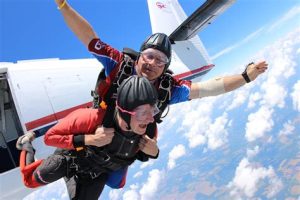Table of Contents
The maximum weight for tandem skydiving varies depending on the drop zone and equipment. Generally, the weight limit ranges from 200 to 250 pounds (90 to 113 kilograms). However, some drop zones may accommodate heavier individuals up to around 300 pounds (136 kilograms). It is essential to check with the specific drop zone for their weight restrictions before booking a tandem skydiving experience.
Are you an adrenaline junkie looking for the ultimate thrill? If so, tandem skydiving might be just the adventure you seek. But before you take the leap of faith, it’s important to know the maximum weight limit for this exhilarating activity. Whether you’re a first-time skydiver or a seasoned pro, understanding the restrictions and guidelines is crucial for your safety and enjoyment. So, let’s dive into the specifics and find out what exactly is the maximum weight for tandem skydiving.
What Is The Maximum Weight For Tandem Skydiving?
Are you an adventure enthusiast looking to experience the thrill of skydiving? Tandem skydiving is a popular choice for beginners, allowing them to enjoy the exhilarating freefall with the guidance of an experienced instructor. However, it’s important to note that there are certain weight restrictions in place to ensure safety during the activity. In this article, we will explore the maximum weight limit for tandem skydiving and why it is crucial to adhere to these guidelines.
Understanding the Importance of Weight Restrictions
Tandem skydiving involves two individuals jumping from an aircraft while harnessed together, with one being the instructor and the other the student. The instructor bears the primary responsibility for controlling the parachute and ensuring a safe landing. Therefore, weight restrictions are in place to ensure that instructors can safely handle the additional load during the jump and landing process.
The Average Maximum Weight Limit
The maximum weight limit for tandem skydiving typically ranges between 225 and 230 pounds (102-104 kg) in most skydiving centers around the world. This weight includes the individual’s body weight as well as the weight of the gear and equipment. However, it’s important to note that weight limits may vary slightly depending on the specific skydiving center and the type of equipment used.
Factors Affecting the Maximum Weight Limit
Several factors influence the maximum weight limit for tandem skydiving. These include:
1. Equipment Capacity
The gear and equipment used in tandem skydiving have specific weight limitations. These limits are determined by the manufacturers based on safety standards and the performance capabilities of the equipment. Exceeding these limits can compromise the safety and functionality of the equipment, hence the importance of adhering to the weight restrictions.
2. Parachute Performance
The performance of the parachute is crucial for a safe and controlled landing. The size and design of the parachute are optimized for a specific weight range. If the combined weight of the instructor and student exceeds this range, it can affect the parachute’s ability to slow down and land safely.
3. Wind Conditions
Wind conditions play a significant role in skydiving safety. Heavier individuals may be more susceptible to stronger wind forces, which can impact their ability to control their body position during the freefall and landing phases. Adhering to weight restrictions helps ensure that participants can maintain control even in varying wind conditions.
4. Instructor Experience
The experience and skill level of the instructor also factor into weight restrictions. While experienced instructors can handle slightly heavier individuals, it is essential to maintain a balance between weight and safety. Instructors need to maintain full control over the jump to ensure the safety of both themselves and the student.
Why Exceeding Weight Limits is Unsafe
Exceeding the maximum weight limit for tandem skydiving can pose significant risks to both the participant and the instructor. These risks include:
1. Difficulty in Maneuvering
When the combined weight exceeds the recommended limit, instructors may find it challenging to control the descent and landing. This can lead to unexpected movements during the freefall, making it difficult to maintain proper body position.
2. Increased Risk of Injury
Exceeding weight limits can put excessive stress on the parachute and other equipment, increasing the risk of malfunction or failure. This heightens the chances of injuries during the jump or landing process, jeopardizing the safety of both the participant and instructor.
3. Reduced Overall Safety
Safety is the utmost priority in skydiving. By adhering to weight restrictions, participants can ensure that they are engaging in a safe and controlled experience. It allows instructors to provide proper guidance and ensures that all equipment functions optimally throughout the jump.
Conclusion
Tandem skydiving is a thrilling adventure that offers an unparalleled adrenaline rush. However, it is crucial to understand and respect the weight restrictions imposed for tandem jumps. By adhering to these limits, you not only prioritize your safety but also enable your instructor to guide you through an unforgettable skydiving experience.
I. Introduction:
Welcome to our guide on the maximum weight for tandem skydiving! In this guide, you will find important information about weight restrictions for tandem skydiving and how it may affect your experience. Please read the following instructions carefully to ensure a safe and enjoyable skydiving adventure.
II. Understanding Weight Restrictions:
Tandem skydiving involves jumping from an aircraft while securely harnessed to a professional skydiving instructor. To ensure safety, there are weight restrictions that need to be followed. This is important because excessive weight may impact the parachute system’s performance and the instructor’s ability to control the skydive effectively.
III. The Maximum Weight Limit:
The maximum weight limit for tandem skydiving can vary depending on the drop zone and the equipment being used. However, in most cases, the weight limit is set around 220 – 240 pounds (100 – 109 kilograms) for safety reasons. Exceeding this limit may result in an increased risk of injury or impaired control during the skydiving experience.
IV. Factors Influencing Weight Limits:
1. Equipment Capacity:
The strength and capacity of the parachute system used for tandem skydiving play a significant role in determining the maximum weight limit. The equipment needs to support the combined weight of the student and instructor during the freefall and landing stages.
2. Instructor’s Training and Experience:
The expertise and physical capabilities of the instructor should also be considered. While experienced instructors can handle higher weights, it’s crucial to maintain a balance between safety and the instructor’s ability to control the skydive.
3. Safety Regulations:
Tandem skydiving is governed by safety regulations and guidelines set by the relevant authorities. These regulations aim to ensure the safety of both the participants and the instructors, and weight limits are a part of these safety measures.
V. Weight-Based Surcharge:
In some cases, individuals weighing close to or over the maximum weight limit may be allowed to skydive but with an additional weight-based surcharge. This surcharge covers the extra resources required to accommodate the higher weight and maintain safety standards.
VI. Contacting the Drop Zone:
To avoid any potential disappointment or inconveniences, it is highly advisable to contact the specific drop zone or skydiving center in advance. They can provide you with accurate information about their weight limits, surcharges (if applicable), and any additional guidelines you need to follow.
VII. Weight Loss Recommendations:
If you are currently above the maximum weight limit for tandem skydiving and are determined to experience this thrilling adventure, it is recommended to consult with a healthcare professional regarding weight loss strategies. Maintaining a healthy weight not only ensures a safe skydiving experience but also promotes overall well-being.
VIII. Conclusion:
Now you have a better understanding of the maximum weight for tandem skydiving. Remember to comply with weight restrictions for your safety and the safety of your instructor. If you have any further questions or concerns, do not hesitate to reach out to a professional skydiving center or drop zone for more information. Soar high and enjoy your exhilarating tandem skydiving experience!
Thank you for choosing our tandem skydiving service! We are excited to provide you with an unforgettable experience. In order to ensure your safety and the safety of our instructors, there is a maximum weight limit for tandem skydiving. Please carefully read the following instructions regarding the maximum weight requirements:
-
The maximum weight for tandem skydiving is 220 pounds (100 kilograms). This includes the weight of all clothing and equipment that you will be wearing during the jump.
-
If you weigh between 200-220 pounds (91-100 kilograms), an additional fee may apply due to the extra equipment and resources required to accommodate for your weight.
-
If you weigh over 220 pounds (100 kilograms), unfortunately, we cannot accommodate you for a tandem skydive. This weight limit is in place to ensure the safety of both the participant and the instructor, as exceeding this limit can put undue strain on the equipment and compromise the integrity of the jump.
-
Please note that upon arrival at our facility, you will be asked to step on a scale to verify your weight. This is a mandatory safety procedure.
-
If you have any concerns or questions regarding the weight limit, please do not hesitate to contact our customer service team before your scheduled jump. We are more than happy to assist you and provide further clarification.
We appreciate your understanding and cooperation in adhering to the maximum weight limit for tandem skydiving. Your safety is our top priority, and we want to ensure that you have a thrilling yet safe experience with us. We look forward to welcoming you and providing you with an exhilarating adventure in the skies!
Thank you for visiting our blog and taking the time to learn more about tandem skydiving. We hope that this article has provided valuable information on the maximum weight limit for this thrilling adventure. Before we conclude, we would like to emphasize a few key points regarding the weight restrictions for tandem skydiving.
Firstly, it is important to understand that weight limits exist for safety reasons. The maximum weight for tandem skydiving typically varies from one drop zone to another, but it generally ranges between 200-250 pounds (90-113 kilograms). This weight restriction is in place to ensure the safety of both the participant and the instructor, as well as to comply with equipment limitations. Exceeding the weight limit can put excessive strain on the parachute system, which may compromise its effectiveness during the jump.
Secondly, it is vital to be honest and accurate about your weight when booking a tandem skydiving experience. Providing incorrect information not only jeopardizes your own safety but also the safety of those who will be accompanying you on this adventure. The instructors and staff at the drop zone are experienced professionals who prioritize safety above all else. By being truthful about your weight, you enable them to make the necessary preparations and adjustments to ensure a safe and enjoyable experience for everyone involved.
In conclusion, tandem skydiving is an exhilarating activity that allows individuals to experience the thrill of freefalling from thousands of feet above the ground. However, it is crucial to recognize and respect the weight restrictions imposed by drop zones. By adhering to these limits, you contribute to the overall safety and smooth operation of the skydiving experience. Remember, safety should always be the top priority, and following the guidelines set by professionals in the industry ensures that everyone can enjoy this incredible adventure to the fullest.
Once again, thank you for reading and we hope this article has answered your questions regarding the maximum weight for tandem skydiving. If you have any further inquiries or would like to book your own tandem skydiving experience, please feel free to reach out to us. Stay safe and have an amazing time exploring the skies!
Video What Is The Maximum Weight For Tandem Skydiving
People Also Ask: What Is The Maximum Weight For Tandem Skydiving?
-
What is the weight limit for tandem skydiving?
The weight limit for tandem skydiving varies depending on the drop zone and the equipment used. In general, most drop zones set a maximum weight limit of around 220-240 pounds (100-109 kilograms) for safety reasons. However, it’s important to note that weight limits can vary, so it’s advisable to check with the specific drop zone you plan to skydive with.
-
Why is there a weight limit for tandem skydiving?
There is a weight limit for tandem skydiving primarily due to safety concerns and equipment limitations. The equipment used in tandem skydiving is designed to handle a certain weight range. Exceeding this weight limit could put excessive stress on the equipment and compromise the safety of the jump. Additionally, the tandem instructor needs to be able to maintain proper control and stability during the skydive, which may become more challenging with heavier individuals.
-
Can I go tandem skydiving if I’m above the weight limit?
If you are above the weight limit set by the drop zone, it is unlikely that you will be able to go tandem skydiving. This is because exceeding the weight limit can pose significant safety risks. It’s essential to follow the guidelines provided by the drop zone to ensure a safe and enjoyable experience for both you and your instructor.
-
Are there any exceptions to the tandem skydiving weight limit?
While exceptions to the weight limit are rare, some drop zones may have specialized equipment or training available for individuals who exceed the standard weight limit. However, these exceptions are typically evaluated on a case-by-case basis and depend on factors such as overall fitness, body proportions, and the availability of suitable equipment. It’s best to contact the drop zone directly to inquire about any potential exceptions or alternatives.
-
What can I do if I’m above the weight limit for tandem skydiving?
If you find yourself above the weight limit for tandem skydiving, you can consider alternative options such as indoor skydiving experiences or seeking out drop zones that offer specialized training and equipment for heavier individuals. Indoor skydiving allows you to experience the sensation of skydiving in a controlled environment without the need for an actual jump. Additionally, some drop zones may provide options for solo skydiving, which typically have higher weight limits compared to tandem jumps.






